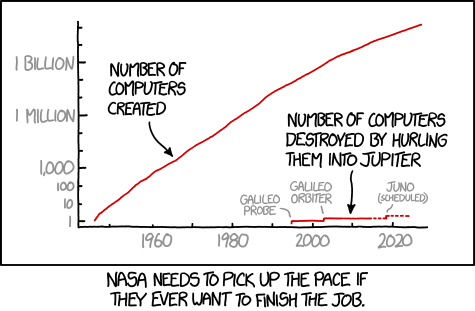1727: Number of Computers
| Number of Computers |
 Title text: They try to pad their numbers in the annual reports by counting Galileo's redundant systems as multiple computers, but they're falling behind badly either way. |
Explanation
| This is one of 59 incomplete explanations: Rough draft, needs better phrasing and transcript If you can fix this issue, edit the page! |
In this comic is a graph of all computers in the world, on a log scale. Also on the page is a graph representing all computers destroyed by throwing them into Jupiter.
Space probes sent to Jupiter are typically scheduled to deorbit and fall into Jupiter's atmosphere. There are multiple reasons for this, including avoiding contaminating Europa with Earth pathogens, never mind the huge gravity well that would have to be overcome for such a probe to return to Earth.
The caption below the comic humorously implies that NASA's reasons for causing the probes to deorbit is merely to destroy computers for the sake of destroying computers (and failing horribly, given they have destroyed three computers out of >100 billion).
Transcript
- [A graph with two red lines. The X-axis is a time-line with eight ticks with every second tick labeled below the axis, ranging from around 1940 to 2030. The Y-axis is a logarithmic count ranging from 1 to 100 billion. There are 12 ticks with the first and then every third tick after that larger than the two ticks in between. All the large ticks are labeled, but only the first two of the small ticks are similarly labeled. Labels are written to the left of the axis. All labels on both axes are written in gray. The first red line is a straight line (thus exponentially growing), starting close to the bottom left corner eventually reaching the upper right edge of the graph. The other red line begins around 1990 and has three straight steps. Each step is labeled with gray text, the last part of the line (after the present 2016), is dotted. Both of the red lines have an arrow pointing to them with a label above the arrow.]
- Left red line: Number of computers created
- Right red line: Number of computers destroyed by hurling them into Jupiter
- Labels on right red line:
- Galileo probe
- Galileo orbiter
- Juno (scheduled)
- 1 billion
- 1 million
- 1,000
- 100
- 10
- 1
- [Caption below the panel:]
- NASA needs to pick up the pace if they ever want to finish the job.
Discussion
Huh. Just noticed I missed a sentence at the beginning, but I'm too lazy to fix it. Could someone else rewrite my horrible draft? 173.245.50.85 06:19, 31 August 2016 (UTC)
- I have done that now. ;-) And added a "few" extra details. --Kynde (talk) 14:52, 31 August 2016 (UTC)
The dotted line may also mean that the mission could possibly be extended, as happened to many NASA missions, in which case the destruction would occur later than currently planned. Zetfr 15:22, 31 August 2016 (UTC)
There's a HAL9000 joke in there all over it. Aasasd (talk) 16:26, 31 August 2016 (UTC)
The line is indicating linear growth, not exponential. Exponential growth would be parabolic, not straight. Tinny 17:20, 31 August 2016 (UTC)
- Note the log scale.162.158.86.137 17:51, 1 September 2016 (UTC)
Did you miss the point about the left axis being logarithmic, or do you need an "explain explain xkcd" page to teach you basic graphing concepts? flounder 108.162.237.136 (talk) (please sign your comments with ~~~~)
If the implied goal is destroying computers in Jupiter I’m afraid it is completely impossible for NASA to finish even if we stopped manufacturing them now. Some computers have already been destroyed by other means. 162.158.74.27 03:01, 2 September 2016 (UTC)
Could there be a reference to Lord of the Rings? Having to travel a long distance to destroy an object in the one location it can be destroyed. 108.162.237.133 (talk) (please sign your comments with ~~~~)
Is that really so hard to send probe on Jupiter orbit into Jupiter? I would expect it would likely happen even if not trying, either because orbit not being totally stable or because the probe will hit something. Or get under Io. ... -- Hkmaly (talk) 21:28, 4 September 2016 (UTC)
Just out of curiosity, does anyone have a source for number of computers created? I'd be really interested to see that, whether it's the one Randall used when making the comic, or a newer source. Thanks! 172.69.69.207 19:38, 29 September 2021 (UTC)
As of 2022, Juno's mission has been extended through at least September, 2025. https://www.nasa.gov/mission_pages/juno/overview/index.html Nitpicking (talk) 12:40, 8 October 2022 (UTC)